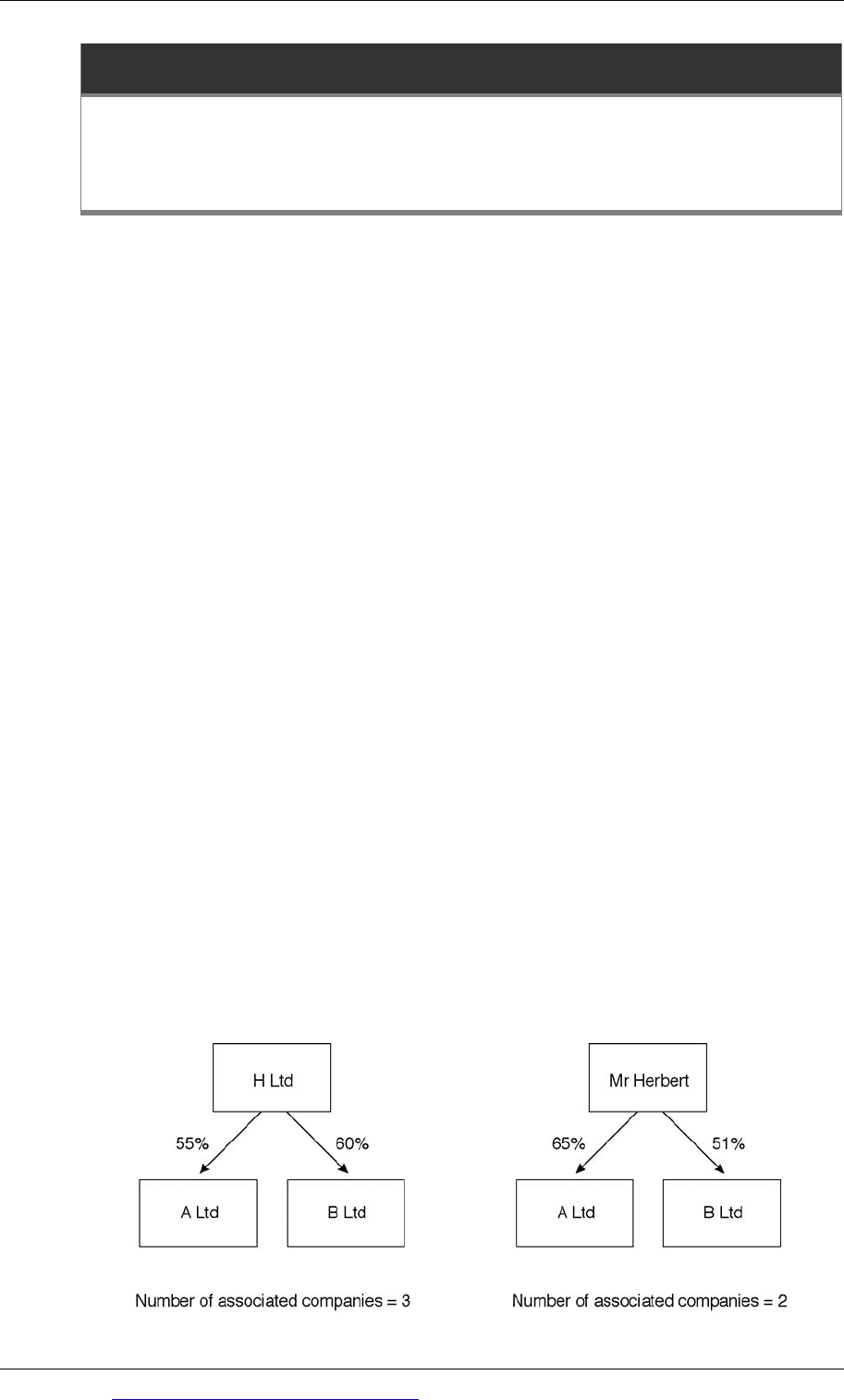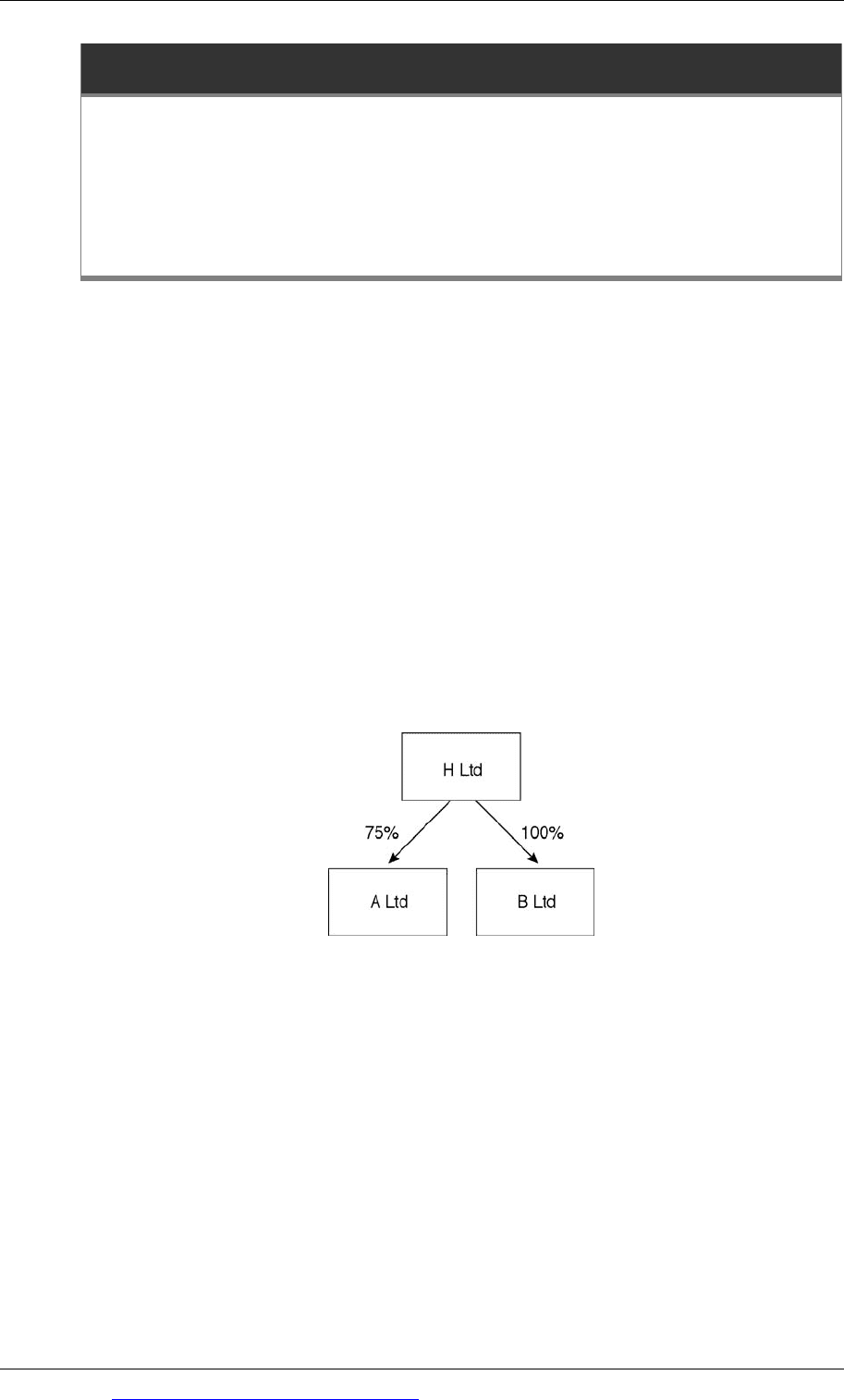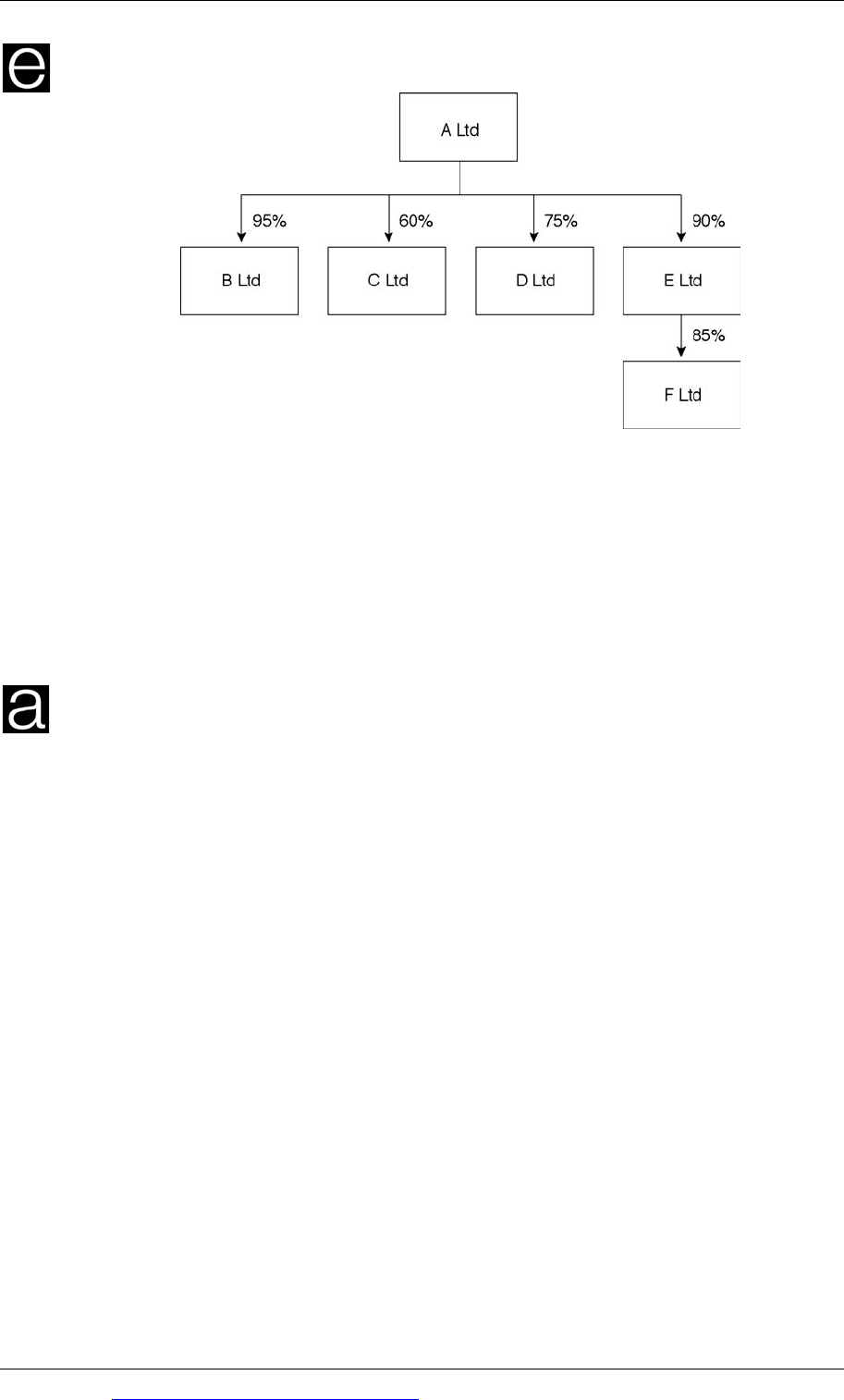ACCA F6 FA09 Study Text 2010
Подождите немного. Документ загружается.


Chapter 20: Overseas aspects of corporation tax
© EWP Go to www.emilewoolfpublishing.com for Q/As, Notes & Study Guides 365
Treatment of intra-group transactions with overseas subsidiaries
An explanation of the problem
The transfer pricing provisions
4 Treatment of intra-group transactions with overseas
subsidiaries
4.1 An explanation of the problem
As a consequence of the close relationship between group companies, intra-group
transactions can be arranged at any price the companies choose, or even free of
charge. As a result, the pricing of intra-group transactions can result in group profits
being transferred from one company in the group to another.
The ability to manipulate the pricing of transactions provides groups with the
possibility of valuable tax planning opportunities (e.g. maximising use of losses
within a group and/or ensuring that profits are taxed at the lowest rate of tax
available within the group).
Such tactics could be particularly useful in international groups, for example
between a UK group company and an overseas group company. By selling to an
overseas subsidiary at a price below market price, or buying goods from an
overseas subsidiary at a price above the market price, profits can be shifted out of
the UK corporation tax charge and advantage taken of tax rates abroad which may
be lower.
However, anti-avoidance legislation (the transfer pricing provisions) has been
introduced to prevent the manipulation of profits in this way.
4.2 The transfer pricing provisions
The transfer pricing rules apply to transactions between 50% group companies. A
50% group exists where one company controls another company or they are both
under common control. (Essentially control exists when there is an interest in the
equity shares of the company in excess of 50%. A more detailed definition of control
is explained in a later chapter.)
For the purposes of the examination, the rules only apply to large groups of
companies. A large group is defined as a group with:
at least 250 employees, and
either revenue of at least €50 million or total assets of at least €43 million.
For corporation tax purposes, groups are responsible for applying the arm’s length
principle to their intra-group transactions.

Paper F6 (UK): Taxation FA2009
366 Go to www.emilewoolfpublishing.com for Q/As, Notes & Study Guides © EWP
An arm’s length price is the price that would be charged in a normal commercial
transaction between two independent parties.
Group companies falling within the rules are allowed to deal with intra-group
transactions in one of two ways:
(1) charge and account for intra-group transactions on an arm’s length basis in
their financial accounts, or
(2) charge and account for the transactions at any desired price, then make an
adjustment in the UK company’s adjustment of profit computation to reflect
all intra-group transactions with that company at an arm’s length price.

© EWP Go to www.emilewoolfpublishing.com for Q/As, Notes & Study Guides 367
Paper F6 (UK)
Taxation FA2009
CHAPTER
21
Group corporation tax
Contents
1 Associated companies
2 Group loss relief
3 Group chargeable gain provisions

Paper F6 (UK): Taxation FA2009
368 Go to www.emilewoolfpublishing.com for Q/As, Notes & Study Guides © EWP
Associated companies
Introduction
Definition of an associated company
Consequences of being associated
1 Associated companies
1.1 Introduction
A group of companies is not treated as a single entity for the purpose of corporation
tax. The consolidated accounts for the group are irrelevant for tax purposes.
Instead, for corporation tax purposes, each company within a group is taxed
separately in its own right.
However, in calculating the corporation tax of each company, the tax legislation
allows the group to deal with certain items on a group wide basis as if it were a
single entity.
When dealing with an examination question involving a group, your starting point
should be to determine the number of associated companies.
1.2 Definition of an associated company
Companies are associated if:
one company is under the control of another, or
two or more companies are under the common control of another person, which
could be another company, an individual or a partnership.
Control in this context means an interest of more than 50% in:
the share capital, or
the voting rights, or
the rights to the distributable profits, or
the net assets on a winding up of the company.
For example:

Chapter 21: Group corporation tax
© EWP Go to www.emilewoolfpublishing.com for Q/As, Notes & Study Guides 369
Where a group relationship exists, the companies are under the common control of
the holding company and therefore they are associated for corporation tax
purposes.
Companies within a group are associated if the company has been part of the group
relationship at any time in the CAP. The definition of associated company therefore
includes companies which have been acquired, or disposed of, part way through the
CAP. These joiners and leavers are deemed to be associated for the entire CAP.
The definition of associated company also includes overseas companies, but it
excludes dormant companies (i.e. non-trading companies).
1.3 Consequences of being associated
The consequences of being associated companies are as follows:
When calculating profits for each company in the group, any intra-group
dividends are ignored entirely. They are not treated as franked investment
income (FII).
For the purpose of establishing the rate of corporation tax applicable to each
company in the group, the statutory limits must be divided by the number of
associated companies.
Example
For the year ended 31 March 2010 I Ltd had PCTCT of £400,000 and did not receive
any dividends. It has three associated companies.
Required
Calculate the corporation tax liability of I Ltd for the year ended 31 March 2010.
Answer
I Ltd – corporation tax liability computation – y/e 31 March 2010
£
PCTCT
400,000
FII Nil
Profits
400,000
Small companies rate
Lower limit
Upper limit
300,000 ÷ 4
1,500,000
÷ 4
75,000
375,000
Decision: Full rate of 28% applies (since profits are above £375,000)
Corporation tax liability
£400,000 × 28%
£112,000
Note
I Ltd has three associated companies, therefore the statutory limits must be divided
by four (i.e. I Ltd plus 3).

Paper F6 (UK): Taxation FA2009
370 Go to www.emilewoolfpublishing.com for Q/As, Notes & Study Guides © EWP
Group loss relief
Definition of a 75% group for group loss relief purposes
An outline of how group loss relief works
The rules for group relief from the surrendering company’s point of view
The rules for group relief from the recipient company’s point of view
Tax planning and group loss relief
2 Group loss relief
2.1 Definition of a 75% group for group loss relief purposes
Where one company owns, directly or indirectly, at least a 75% interest in the
ordinary share capital of another company, group loss relief (often referred to
simply as group relief) may be available.
For group relief to be available, the company must also own at least 75% of the
rights to the distributable profits and the net assets on a winding up of the
company. However, for the examination, the ownership of the shares is the key
deciding factor.
Directly-owned 75% subsidiaries will be part of a loss relief group. For example:
Both A Ltd and B Ltd are directly owned 75% subsidiaries of H Ltd for group loss
purposes.
Indirect subsidiaries (sub-subsidiaries)
An indirect subsidiary is the term used to refer to the situation where the holding
company of a group owns shares in a subsidiary via another company (often
referred to as a sub-subsidiary).

Chapter 21: Group corporation tax
© EWP Go to www.emilewoolfpublishing.com for Q/As, Notes & Study Guides 371
Example
In this situation, the sub-subsidiary (B Ltd) can only be part of the holding
company’s loss relief group if the holding company (H Ltd) has an effective interest
of at least 75% in the sub-subsidiary (B Ltd).
The size of the effective interest is calculated by multiplying together:
the percentage of the subsidiary owned by the holding company, and
the percentage of the sub-subsidiary owned by the subsidiary.
In the above example, the effective interest of H Ltd in the sub-subsidiary B Ltd is
81% (= 90% × 90%). Both A Ltd and B Ltd are therefore 75% subsidiaries of H Ltd
for group loss relief purposes.
The composition of a loss relief group
To determine the composition of a loss relief group, both UK and overseas
companies in the group are considered. For example, an overseas holding company
with two UK 75% subsidiaries would form a loss relief group.
However, under the group loss relief provisions, it is only possible to move losses
between the UK companies in the group.
A company can be the member of more than one loss relief group.

Paper F6 (UK): Taxation FA2009
372 Go to www.emilewoolfpublishing.com for Q/As, Notes & Study Guides © EWP
Example
Required
Calculate the number of associated companies and state which companies form a
loss relief group making each of the following alternative assumptions:
(a) All companies are UK companies
(b) A Ltd is an overseas company.
Answer
(a) Assuming all companies are UK companies
Number of associated companies = 6
All the companies are associated as A Ltd has an interest of more than 50% in
each.
Loss relief group = A Ltd, B Ltd, D Ltd, E Ltd and F Ltd
Notes
(1) C Ltd is not included as A Ltd owns less than 75%.
(2) F Ltd is included as A Ltd has an effective interest of at least 75% (90% ×
85% = 76.5%).
(b) Assuming A Ltd is an overseas company:
The answer is the same as above in (a):
Overseas companies are associates; therefore there are still 6 associated
companies.
The composition of a loss relief group includes overseas companies; the
group is therefore defined as above.
However, group losses may only move between the UK-resident companies
(i.e. between B Ltd, D Ltd, E Ltd and F Ltd).

Chapter 21: Group corporation tax
© EWP Go to www.emilewoolfpublishing.com for Q/As, Notes & Study Guides 373
2.2 An outline of how group loss relief works
The group relief provisions allow losses to be transferred in any direction between
UK companies within a loss relief group.
The loss relief is deducted from the PCTCT of the recipient company and therefore
reduces its corporation tax liability.
Group relief is not automatic. It must be claimed within two years of the end of the
CAP of the company receiving the group relief.
2.3 The rules for group relief from the surrendering company’s point of view
The following losses can be surrendered:
trading losses
unrelieved UK property business losses (i.e. losses left unrelieved after making a
the claim against total profits for the current period)
unrelieved Gift Aid donations.
It is important to note that capital losses cannot be surrendered (but see below).
Only current period losses can be surrendered. It is not possible to surrender losses
brought forward from a previous CAP or carried back from a later CAP.
The surrendering company can give away any amount of its current period losses to
one or several other group companies.
The surrendering company can utilise its own losses against its own profits (for
example, with a s393A claim) before surrender, if it wishes to do so. However, it is
not obliged to utilise its own losses first. It can transfer all its losses, and pay tax
itself, if it wishes to do so for tax planning reasons or other commercial reasons.
However, it cannot surrender all its losses if the recipient company can not utilise
them all against its own available profits.
2.4 The rules for group relief from the recipient company’s point of view
The recipient company can only accept losses up to the amount of its available
profits.
Available profits are defined as PCTCT after deducting the following amounts
relating to the recipient company:
any trading losses brought forward
a current period loss relief claim under s393A (see below), and
current period Gift Aid donations.

Paper F6 (UK): Taxation FA2009
374 Go to www.emilewoolfpublishing.com for Q/As, Notes & Study Guides © EWP
In calculating the available profits, a current period s393A claim must be deducted
even if a claim is not actually made. However, there is no requirement to take
account of a carry back claim under s393A.
Losses can only be matched against profits of a corresponding accounting period.
(i.e. the period when both the surrendering and recipient company were part of the
same group).
If both companies have the same CAPs and are part of the group for the whole CAP
the position is straightforward. The maximum group relief claim = Lower of:
the loss of the surrendering company, or
the available profits of the recipient company.
Year ends that are not coterminous
Where the two companies have non-coterminous year ends (i.e. they do not have
the same year end dates) or where a company joins or leaves a group during the
CAP, the maximum group relief available is calculated by time-apportionment of:
the surrendering company’s losses, and
the recipient company’s available profits.
In effect, this means that the available profits are matched with the available losses
in the common CAPs.
Example
G Ltd owns a 100% subsidiary, K Ltd. In the year ended 30 September 2009 the two
companies had the following results:
G Ltd K Ltd
£ £
Trading profit / (loss) (125,000) 28,000
Interest income
20,000 20,000
Net chargeable gain
Nil 135,000
Gift Aid payment
(2,000) (5,000)
Trading loss brought forward
(10,000) (50,000)
Required
Calculate the maximum group relief surrender for the year ended 30 September
2009.
